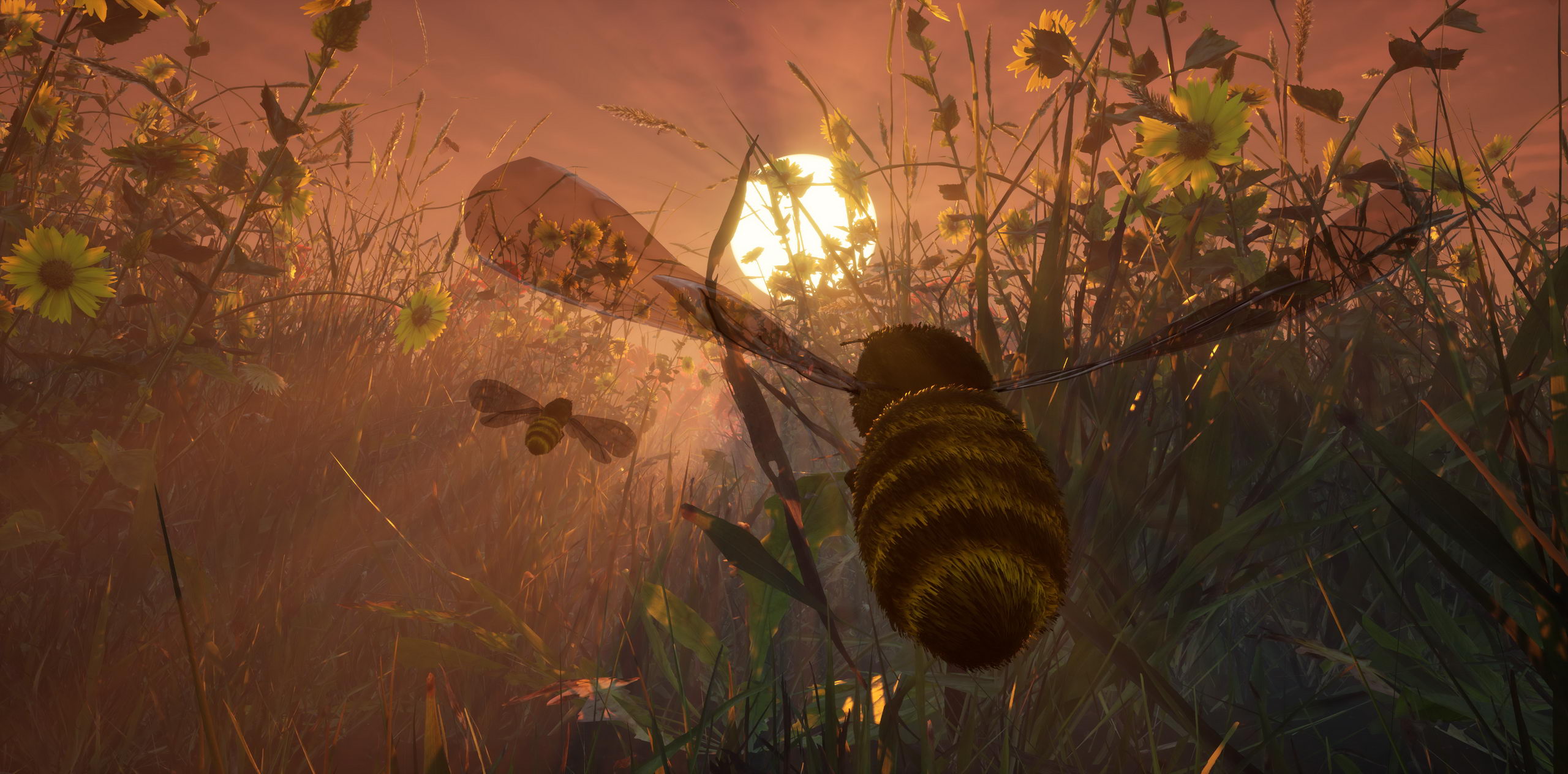Image credit: “Beeing” © 2021 Filmakademie Baden-Württemberg
Climate change, environmental protection, and sustainability are prominent topics of concern worldwide. SIGGRAPH 2021 Talks selection “Beeing — Nature Inspired VR Journey” is a prototype showcasing how a synchronized virtual reality (VR) experience can add customer value to a daily commute in short distance trains, therefore encouraging more users to take advantage of public transit. “Beeing” aims to convey that nature must be preserved so that society can continue experiencing it in real life, not just VR. We caught up with SIGGRAPH contributor Volker Helzle to learn more about how “Beeing” adds to the broader environmental conversation and what’s next for the project.
SIGGRAPH: Share some background about your SIGGRAPH 2021 Talk. What inspired the experience you shared? Why was VR the right medium for it?
Volker Helzle (VH): VR has found broad adoption during the last [few] years. Powerful devices and streamlined content creation led to a wide variety of applications. The “Beeing” experience is trying to identify new use-cases for VR in uncharted territory, like public transportation. [In the experience,] you find yourself on the back of an insect after the train disintegrates, which carries you through a fantastic and ominously dissolving forest of ghosts. The ride ends in a flower meadow showing the beauty of nature. The aim is to convey that nature must be preserved so that it can continue to be experienced outside VR in the future.
SIGGRAPH: In your abstract, you mention that demand for increased use of public transportation is on the rise. How does “Beeing” contribute to the larger climate and environmental conversation?
VH: “Beeing” is a prototype showcasing how a synchronized VR experience can add customer value to a daily commute in short distance trains. In order to improve the attractiveness of public transportation, we created the “Beeing” experience in sync with trains’ physical movements. The project should be considered a concept at this stage, but with big potential. Content can be dynamically adjusted to any railroad condition and, as such, be applied to any subway network worldwide.
SIGGRAPH: What obstacles did you overcome during development?
VH: The biggest challenge was to determine the viewer’s position and the start of the train. While data for the train is usually available within its local network, it is not available to passengers. We had to find smart ways to work with GPS and compass data in conjunction with the railway track and topological information gathered from public maps. Our engineers also had to create a speed drift compensation, resulting in unnoticeable acceleration and deceleration of the content. We also worked in different engines for content creation (Unreal) and experience playback (Unity). All in all, there were quite a few challenges that our engineering team solved successfully.
SIGGRAPH: Why is it important to provide a variety of entertaining content between train stations? What entertainment does that involve, and how does it impact the user’s experience?
VH: At this point in time, we only managed to realize one example experience. Our user study was mostly relating to how well the physical experience during the train ride matched the virtual experience. This resulted in multiple adjustments to find a satisfying “train start” mechanism. We tested this with offline data we tracked during a train ride. The next step was a real, live test. The overall experience convinced the participants conducting the tests and found it to be an interesting entertainment alternative. You can watch the full movie in the 360 VR video below.
SIGGRAPH: What’s next for “Beeing”?
VH: “Beeing” was embedded into a larger project by the Application Center VR/AR. The goal of this project was to create general awareness of XR and its potential in applications for regional small- and medium-sized enterprises in our federal state Baden-Württemberg. At the moment, we are in preparation for two large, European-level projects, both on extended reality, so stay tuned, there is a lot more to come.
SIGGRAPH: What advice do you have for someone planning to submit a Talk to a future SIGGRAPH conference?
VH: SIGGRAPH is a large conference with a lot of different formats for contributions. Make sure you understand each format’s requirements in order to meet them and be successful. I also advise to consult a senior researcher, developer, or artist that has been an active contributor for advice, and ask them to review your submission. Note deadlines early in your calendar and start on time. The submission date is always a week too early, no matter how well prepared you are.
Ready to learn about more novel VR experiences like “Beeing”? Join us in Vancouver, online, or for a hybrid experience this summer at SIGGRAPH 2022! Register now.
 Volker Helzle is in charge of research and development at Animationsinstitut of Filmakademie Baden-Württemberg. After graduating from Stuttgart Media University in 2000, he moved to California and worked at Eyematic Interfaces. In 2003, he joined Filmakademie to supervise research and innovation. He is the senior lecturer for the technical directing course and FMX program consultant. In 2013, Helzle received the honorary professorship of Filmakademie. Being a C-64 kid of the ‘80s, Helzle’s life was strongly influenced by video games and early computer graphics. To this day he is a passionate gamer but also finds interest in analog activities like mountain hiking, gardening, or yoga. As of January 2019, an improved version of Helzle is available that keeps him busy day and night.
Volker Helzle is in charge of research and development at Animationsinstitut of Filmakademie Baden-Württemberg. After graduating from Stuttgart Media University in 2000, he moved to California and worked at Eyematic Interfaces. In 2003, he joined Filmakademie to supervise research and innovation. He is the senior lecturer for the technical directing course and FMX program consultant. In 2013, Helzle received the honorary professorship of Filmakademie. Being a C-64 kid of the ‘80s, Helzle’s life was strongly influenced by video games and early computer graphics. To this day he is a passionate gamer but also finds interest in analog activities like mountain hiking, gardening, or yoga. As of January 2019, an improved version of Helzle is available that keeps him busy day and night.



